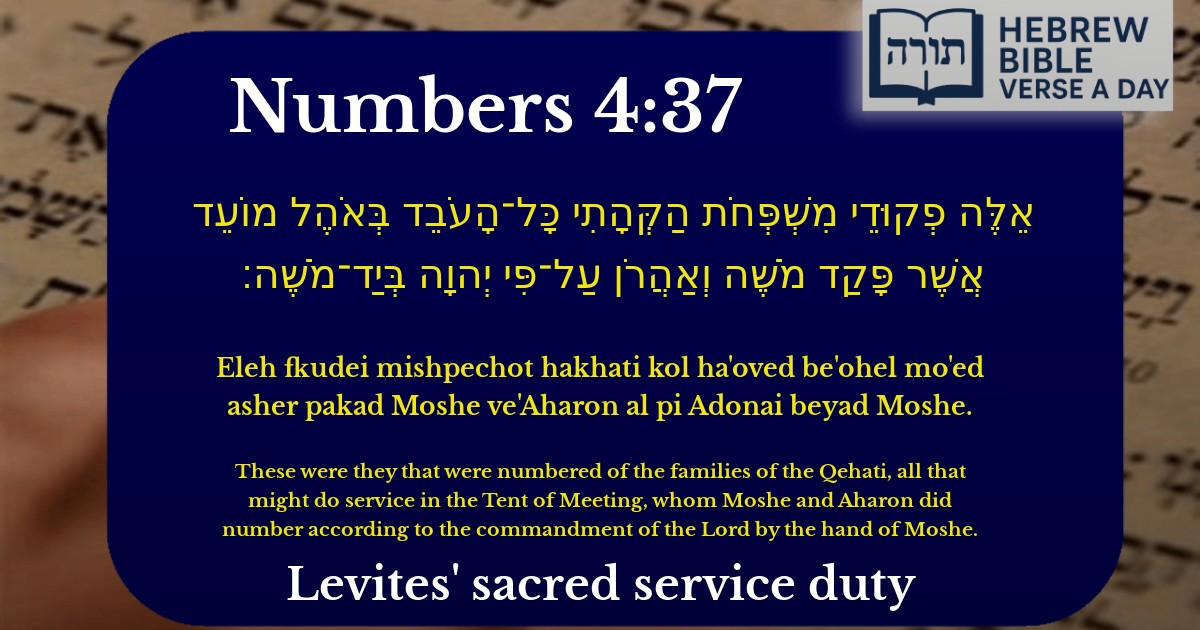Join Our Newsletter To Be Informed When New Videos Are Posted
Join the thousands of fellow Studends who rely on our videos to learn how to read the bible in Hebrew for free!
Hebrew Text
אֵלֶּה פְקוּדֵי מִשְׁפְּחֹת הַקְּהָתִי כָּל־הָעֹבֵד בְּאֹהֶל מוֹעֵד אֲשֶׁר פָּקַד מֹשֶׁה וְאַהֲרֹן עַל־פִּי יְהוָה בְּיַד־מֹשֶׁה׃
English Translation
These were they that were numbered of the families of the Qehati, all that might do service in the Tent of Meeting, whom Moshe and Aharon did number according to the commandment of the Lord by the hand of Moshe.
Transliteration
Eleh fkudei mishpechot hakhati kol ha'oved be'ohel mo'ed asher pakad Moshe ve'Aharon al pi Adonai beyad Moshe.
Hebrew Leining Text
אֵ֤לֶּה פְקוּדֵי֙ מִשְׁפְּחֹ֣ת הַקְּהָתִ֔י כׇּל־הָעֹבֵ֖ד בְּאֹ֣הֶל מוֹעֵ֑ד אֲשֶׁ֨ר פָּקַ֤ד מֹשֶׁה֙ וְאַהֲרֹ֔ן עַל־פִּ֥י יְהֹוָ֖ה בְּיַד־מֹשֶֽׁה׃ {ס}
Parasha Commentary
📚 Talmud Citations
This verse is not quoted in the Talmud.


Overview of the Verse
The verse (Bamidbar 4:37) enumerates the families of the Kehati (the descendants of Kehat, a son of Levi) who were assigned specific duties in the Mishkan (Tabernacle). It emphasizes that Moshe and Aharon conducted this census in accordance with Hashem's command, underscoring the divine authority behind their roles.
Rashi's Commentary
Rashi explains that the phrase "אֵלֶּה פְקוּדֵי מִשְׁפְּחֹת הַקְּהָתִי" ("These were they that were numbered of the families of the Qehati") refers specifically to those who were fit for service—men between the ages of 30 and 50 (as per Bamidbar 4:3). He notes that the counting was precise and purposeful, ensuring only those capable of the sacred work were included.
Rambam's Perspective
Rambam (Hilchos Klei HaMikdash 3:1-2) derives from this verse the principle that service in the Mishkan (and later the Beis HaMikdash) must be performed by those designated and trained for it. The phrase "עַל־פִּי יְהוָה בְּיַד־מֹשֶׁה" ("according to the commandment of the Lord by the hand of Moshe") reinforces that these roles were not arbitrary but divinely ordained through Moshe Rabbeinu.
Midrashic Insights
The Midrash (Bamidbar Rabbah 6:5) highlights the significance of the Kehati family's role, as they were entrusted with carrying the most sacred vessels of the Mishkan, including the Aron (Ark). Their service required exceptional care and reverence, reflecting their elevated spiritual status among the Levi'im.
Key Themes